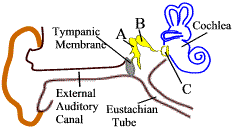| Preparation |
Just what you need to know ! |
Sound is produced by the vibrations in a vibrating material body.
Vibration is defined as the to and fro motion of a vibrating particle about its mean position.
Frequency is defined as the number of vibrations produced by a vibrating body in one second.
The SI unit of frequency is Hertz (Hz).
Sonic vibrations have their frequency between 20 Hz and 20000 Hz.
They can be perceived by the human ear.
They are also referred to as sound vibrations.
Infrasonic vibrations have their frequency lower than 20 Hz.
They cannot be perceived by the human ear.
They are also referred to as subsonic vibrations.
Ultrasonic vibrations have their frequency higher than 20000 Hz.
They cannot be perceived by the human ear.
They are also referred to as supersonic vibrations.
Ultrasonic vibrations are used for various purposes such as homogenizing milk, dish-washing and imaging internal human organs.
These vibrations can be heard by animals like bats and dolphins, who use them for locating their prey.
Sound obeys the laws of reflection. It can be reflected as well as refracted.
Echo is the repetition of sound when it is reflected from a distant object.
It has been observed that the distance between the source of the sound and the reflecting body should be at least 17 metres for the echo to be audible.
Also, the loudness of the sound should be sufficient enough that the sound is clearly audible even after reflection.
Sonar is the device used in ships for determining the depth of the sea below the ship.
It is based on the principle of the reflection of ultrasonic sound waves.
Material medium is absolutely essential for the propagation of sound.
Sound cannot travel through vacuum.
Sound travels fastest in solids (its speed is about 5000 m/s in steel and glass), slower in liquids (its speed is about 1300-1600 m/s in water) and slowest in gases (its speed is 330 m/s in air).
Sound of thunder is heard after the flash of lightning is seen.
This is because light travels at a very fast speed of 3 × 108 m/s, whereas sound travels in air at about 330 m/s.
 Human eardrum, which lies at the end of the six cm long external auditory canal, separates the outer and middle ears. Human eardrum, which lies at the end of the six cm long external auditory canal, separates the outer and middle ears.
When sounds reach the eardrum or tympanic membrane, they make it vibrate.
The vibrations of the eardrum are transmitted by three little bones (hammer labeled A, anvil labeled B and stirrup labeled C) to the cochlea.
The cochlea (Latin for snail) is a coiled tube, which has an oval window only one-sixteenth the area of the eardrum to receive vibrations and contains the actual organ of hearing.
The Eustachian tube (named after the anatomist Eustachius) keeps the pressure in the middle ear the same as the outside air pressure. It is this pressure that changes when flying in an aircraft, causing a temporary deafness.
Physics Quiz on Sound. |
